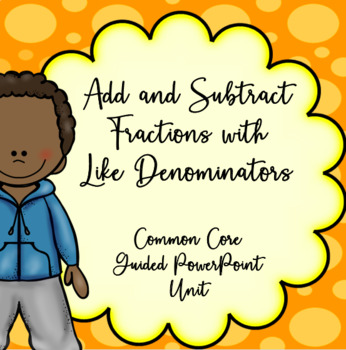4th Grade Add and Subtract Fractions, Guided PowerPoint Unit, Common Core
- PPTX
Also included in
- *Similar to my enVision 2.0 and 2012 PowerPoint slides, but these can be used to supplement ANY curriculum -! If you already purchased the EnVision version, you will NOT need to purchase this one as well. I also have a GOOGLE SLIDE VERSION of this product in my store.Use these 10 units as a supplemePrice $29.25Original Price $32.50Save $3.25
Description
Ready to go, Daily Lessons, done for you!
This PowerPoint contains 236 slides that walk your students through 11 lessons, teaching them how to add and subtract fractions and mixed numbers (with like denominators). These slides can be used to supplement the curriculum you already have or it can be used as a stand alone unit! These lessons are aligned to the 4th grade Common Core Standards. Everything you need, from guided practice to learning of vocabulary and application of skills is here! Check out the list of lessons below! *More units can be found in my store*
Lessons in this unit include
Lesson 1 - Modeling Addition of Fractions
Lesson 2 - Adding Fractions with Like Denominators
Lesson 3 - Modeling Subtraction of Fractions
Lesson 4 - Subtracting Fractions with Like Denominators
Lesson 5 - Adding and Subtracting Fractions on the Number Line
Lesson 6 - Improper Fractions and Mixed Numbers
Lesson 7 - Modeling Addition and Subtraction of Mixed Numbers
Lesson 8 - Adding Mixed Numbers
Lesson 9 - Subtracting Mixed Numbers
Lesson 10 - Decomposing and Composing Fractions
Lesson 11 - Problem Solving with Fractions
Each day begins with a lesson title, the objective for the day (I have students volunteer to read this part), any needed vocabulary, and then guided practice problems with explanations and problems for students to answer independently as they apply what they've learned and work towards mastery. The lessons conclude with a discussion question that reviews what was learned and brings it all together. I provide answer slides after the questions so that students can also compare their answers for accuracy. Sides take it slow, so students start off by not only practicing the skill, but learning how and why steps are taken in order to solve.
Slides give guidance for you, too! I have small notes letting you know if you should "go on" to next slide and also give you a heads up if the next slide contains the answer, so you don't show it before students have an opportunity to solve it themselves. I use these notes for myself as well, because I can never remember what slide comes next. This makes them foolproof!
They are fully editable so you can add/change anything that you need to meet the needs of your classroom. I like to add a slide at the end of the lesson with "next steps" that may include their independent classwork assignment, their homework assignment, reminders about tests, or anything else you want to post to guide through the last part of the math period.
*Please leave feedback and earn TpT credits in the process! Thank you!






